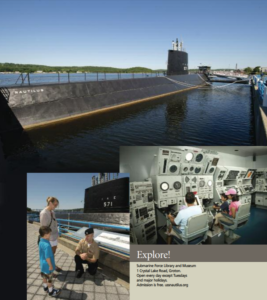by Karin Peterson
(c) Connecticut Explored Inc. SPRING 2014
Subscribe/Buy the Issue!
Connecticut’s own USS Nautilus was revolutionary when she was launched in 1954 as the world’s first nuclear-powered submarine. She continued to set world records, the most noteworthy being that she was the first vessel to travel under the North Pole. After 25 years of service, the Nautilus returned to her Groton birthplace to launch a second career as a museum of submarine history, the first such facility in the world. The USS Nautilus was designated a National Historic Landmark in 1982 and named Connecticut’s State Ship in 1983.
 The idea to use atomic energy for naval propulsion, especially for submarines, was discussed as early as the 1930s, but the navy did not begin exploring the potential of this new technology until after World War II. Capt. Hyman Rickover, later dubbed the “Father of the Nuclear Navy,” was assigned to one of the design teams, and when the first nuclear-powered submarine was finally authorized, Rickover personally planned and supervised its construction. On June 14, 1952, President Harry Truman came to General Dynamic’s Electric Boat Division in Groton to lay the keel, and on January 21, 1954, First Lady Mamie Eisenhower christened the new submarine the USS Nautilus. Thanks to Rickover’s strong leadership, the ship put out to sea just two weeks behind the schedule that had been set in 1949.
The idea to use atomic energy for naval propulsion, especially for submarines, was discussed as early as the 1930s, but the navy did not begin exploring the potential of this new technology until after World War II. Capt. Hyman Rickover, later dubbed the “Father of the Nuclear Navy,” was assigned to one of the design teams, and when the first nuclear-powered submarine was finally authorized, Rickover personally planned and supervised its construction. On June 14, 1952, President Harry Truman came to General Dynamic’s Electric Boat Division in Groton to lay the keel, and on January 21, 1954, First Lady Mamie Eisenhower christened the new submarine the USS Nautilus. Thanks to Rickover’s strong leadership, the ship put out to sea just two weeks behind the schedule that had been set in 1949.
It was a momentous milestone when Nautilus Commander Eugene Wilkinson radioed, “Underway on nuclear power” as the submarine traveled down Connecticut’s Thames River on January 17, 1955. The successful launching of the first atomic submarine boosted American prestige during the Cold War. Nuclear power gave the Nautilus crucial advantages. Since nuclear power produces no emissions and needs no air, the submarine could stay underwater for long periods. It could remain submerged for more than two weeks, unlike conventional submarines, which were limited to 12 to 48 hours. The new submarine’s ability to move fast and dive quickly immediately made existing anti-submarine warfare obsolete. However, it was discovered that the sub’s hull and superstructure vibrated when she traveled above certain speeds, which made the vessel vulnerable to detection and affected sonar operation.
After the Russians shot the satellite Sputnik into space in 1957, America needed a similar achievement to enhance its international standing. President Eisenhower ordered the Nautilus to attempt a passage under the North Pole. The submarine’s ability to stay submerged and its speed made the trip feasible, but far from easy. Traditional navigational instruments did not work at extreme latitudes, and the crew risked becoming disoriented under the ice. That challenge was overcome by newly installed navigational technology developed for cruise missiles supplemented by a specially developed gyrocompass.
The first attempt of this secret mission, whose code name was “Operation Sunshine,” failed due to deep ice in the shallow water of the Bering Strait. After waiting for conditions to improve, the Nautilus tried again, this time using a known channel where the likelihood of being detected was heightened. The ship passed undetected by other nations under the geographic North Pole on August 3, 1958. She re-surfaced near Greenland two days later.
When Secretary of Defense Harold Brown announced in January 1978 that the Nautilus would shortly retire from service, 10 possible museum locations were considered. The Connecticut Historical Commission (now the Historic Preservation Council) acted quickly and within days of the announcement had adopted a resolution urging Governor Ella Grasso, the Connecticut General Assembly, and the state’s U.S. Congressional delegation to push for the submarine’s return to Connecticut.
Although reports suggested that the Washington Navy Yard had been selected, according to Connecticut Historical Commission chairman John Shannahan. Gov. Grasso lobbied President Jimmy Carter, who ordered the Nautilus to Groton after all. Shannahan, who also served as Connecticut’s historic preservation officer, assumed the additional responsibility of becoming unpaid executive director of the non-profit Connecticut Nautilus Committee to work with the U.S. Navy and the tourism staff of the DECD to create the new museum. Funding came from the State of Connecticut, the federal government, and private donors. The USS Nautilus was designated a National Historic Landmark in 1982 and named the state’s official ship in 1983.
The Submarine Force Library and Museum opened in Groton in April 1986 with the USS Nautilus as its centerpiece. The museum offers exhibits interpreting submarine history and an extensive research library. The submarine is moored alongside the building and is open for self-guided tours. Within three years of opening, the museum welcomed its one-millionth visitor.
Karin Peterson was museum director for the Department of Economic and Community Development.
Explore!
Read more!
“Electric Boat: Full Speed Into the Nuclear Age,” Winter 2015/2016
“Five Connecticuts Defend our Nation,” Spring 2009
More Connecticut maritime history: Spring 2009
Submarine Force Library and Museum
1 Crystal Lake Road, Groton.
Open every day except Tuesdays and major holidays. Admission is free.
ussnautilus.org

